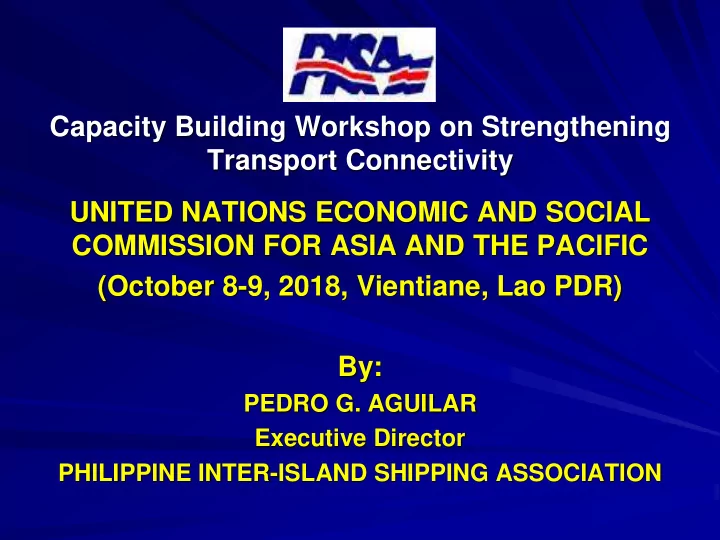

Capacity Building Workshop on Strengthening Transport Connectivity UNITED NATIONS ECONOMIC AND SOCIAL COMMISSION FOR ASIA AND THE PACIFIC (October 8-9, 2018, Vientiane, Lao PDR) By: PEDRO G. AGUILAR Executive Director PHILIPPINE INTER-ISLAND SHIPPING ASSOCIATION
Outline of Presentation ― Brief Introduction of PISA Status of Philippine coastal shipping Philippine Coastal Shipping Challenges / Issues Issues related to domestic ferry safety Opportunities for Philippine Coastal Shipping / Plans to Promote Coastal Shipping
What is PISA? PISA is the umbrella organization of domestic shipping and shipping-related associations. Established in 1977, PISA represents a cross- section of the Philippines’ maritime industry. Its membership includes domestic shipowners, as Regular Members, from the following sectors: (a) Dry Cargo (container/ bulk/ breakbulk), (b) tankers; (c) Ro-Ro and Ro-Pax; (d) Harbor Tugs,
What is PISA? and Associate Members from marine related companies such as: a. Deep sea fishing b. Classification societies c. Protection and indemnity insurance d. Ship building and ship repair
What is PISA? PISA, through its Chairman and President, sits as a private sector representative in the Board of Directors of the country’s flag administration ─ the MARITIME INDUSTRY AUTHORITY (or MARINA ) PISA is also a member of the Maritime Industry Tripartite Council (MITC) of the Dept. of Labor & Employment. MITC is a consultative body on matters pertaining to labor issues involving seafarers.
The Philippines (An archipelago of 7,600+ islands)
Major Shipping routes for cargo and passenger
Brunei Darussalam-Indonesia- Malaysia-Philippines East ASEAN Growth Area (BIMP-EAGA) BIMP-EAGA covers the entire sultanate of Brunei Darussalam; the provinces of Kalimantan, Sulawesi, Maluku and West Papua of Indonesia; the states of Sabah and Sarawak and the federal territory of Labuan in Malaysia; and Mindanao and the province of Palawan in the Philippines.
Brunei Darussalam-Indonesia- Malaysia-Philippines East ASEAN Growth Area (BIMP-EAGA) BIMP-EAGAcooperation aims to increase trade, tourism, and investments by: Facilitating the free movement of people, goods, and services; Making the best use of common infrastructure and natural resources; and Taking the fullest advantage of economic complementation.
Status of Philippine Coastal Shipping Philippine Coastal Shipping is alive and very dynamic as it is governed by Republic Act No. 9295 of the “Domestic Shipping Development Act”
Status of Philippine Coastal Shipping Under the law, it is the policy o f the state (a) promote Filipino ownership of vessels operated under Philippine flag; (b) attract private capital to invest in the shipping industry by creating a healthy and competitive investment and operating environment; (c) provide necessary assistance and incentives for the continued growth of the Philippine domestic merchant marine fleet; (d) encourage the improvement and upgrading of the existing domestic merchant marine fleet and Filipino crew to meet international standard; (e) ensure the continued viability of domestic shipping operations; and (f) encourage the development of a viable shipbuilding and ship repair industry to support the expansion and modernization of the Philippine domestic merchant marine fleet and its strict adherence to safety standards which will ensure the seaworthiness of all sea-borne structures
Status of Philippine Coastal Shipping Fleets/Vessels – Statistics on Ship type, Size (as of 2018 )
Philippine Coastal Shipping Challenges/Issues High Cost of Doing Business ― High cost of vessel acquisition High Cost of Drydocking High Cost of Fuel High Taxation Poor Port Infrastructure ― Most ports cannot accommodate bigger ships, hence, economies of scale is not achieved Prolong stay of ships in ports due to poor or inadequate port facilities
Philippine Coastal Shipping Challenges/Issues Bureaucratic Red Tape ― There are more or less twenty one (21) government agencies that directly and indirectly regulate the domestic shipping industry in the Philippines
Issues related to domestic ferry safety Old and poorly maintained ships, average of Philippine fleet ─ 25 years ol d Wooden hulled ships ─ bancas with outriggers High cost of replacing wooden hulled ships with steel/aluminum or fiberclass
Opportunities for Philippine Coastal Shipping / Plans to Promote Coastal Shipping MARINA, the Philippine Flag Administration has formulated a “MARITIME INDUSTRY DEVELOPMENT PLAN” (MIDP) for signature of the President.
Opportunities for Philippine Coastal Shipping / Plans to Promote Coastal Shipping MIDP Program 1 ─ “UPGRADING DOMESTIC SHIPPING IN SUPPORT OF THE NAUTICAL HIGHWAY DEVELOPMENT PROGRAM” which includes the following:
Opportunities for Philippine Coastal Shipping / Plans to Promote Coastal Shipping Modernization and upgrading of domestic ships Development of new shipping routes/links and Implement Route Rationalization Improvement/expansion of existing ports, and development of new port infrastructures
THANK YOU !
Recommend
More recommend